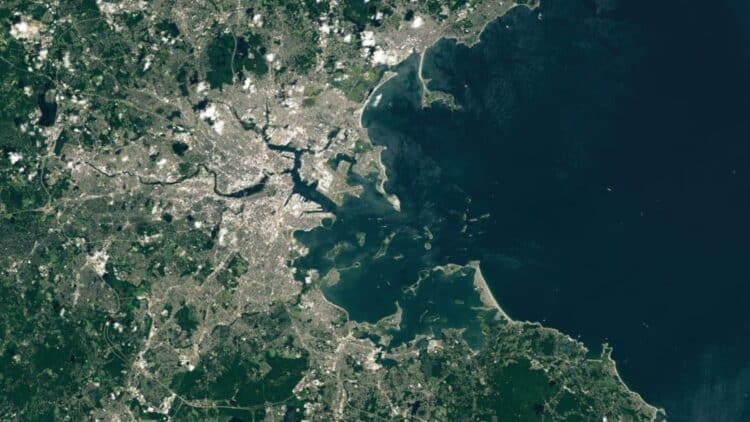According to NASA’s Earth Observatory, a remarkable discovery situated on the Boston coastline serves as a subject of scientific wonder. Research using satellite imagery from July 19, 2024, through the Landsat 8 Operational Land Imager showed that Boston Harbor contains an exclusive geological structure that ranks it as one of three places worldwide. The prehistoric landforms deliver information about the enormous glacial power that formed our continent.
The American coastal understanding undergoes all-encompassing changes
The 34 islands and peninsulas within Boston Harbor took shape as glacial drumlins, which developed nearly 20,000 years ago. During the Wisconsin Glaciation, the region received full ice sheet coverage exceeding one mile deep from approximately 100,000 to 75,000 years ago. The glacier vanished completely as it melted while creating these distinct rock structures that later became submerged beneath increasing ocean waters.
These islands stand apart from all other Earth features because of several unique aspects
Scientists consider these islands the sole partially submerged drumlin field in North America while counting them among the three similar formations worldwide. The nearest equivalent drumlin islands exist in Clew Bay, Ireland, with a myth that the area contains 365 drumlin islands for the full 365 days of the year. The scarcity of geological features in Boston Harbor adds meaning to glacial history studies.
NASA utilized multiple hidden elements that resulted in the solution of this 20,000-year-old mystery
The findings changed everything about how researchers study glacial movement. Jasper Knight, a geoscientist from the University of Witwatersrand, explains that these formations contradict former ideas about glacial movements. Previous theories about glacier movement in slow, steady patterns have been disproved. Knight discussed glacier dynamics when he spoke to NASA in 2016.
Scientists investigated the strategic Boston Harbor location
Several ecological environments, including salt marshes, now occupy the drumlin islands together with sandy beaches along with tidal mudflats and grasslands and sea-grass beds and hardwood forests, and tidal pools. A multitude of wild creatures inhabit these islands since they host sea creatures, including mussels and barnacles, alongside various mammals, birds, reptiles, amphibians, and others. The evolving species settled into existence on the ground that ice had sculpted.
These archaeological elements remain concealed inside these natural geological features
The islands have preserved Boston Light at Little Brewster Island as the oldest functioning lighthouse, which began shining during 1716. The island of Georges housed Fort Warren, which stored Confederate officers together with government officials during detention, allowing Vice President Alexander Stephens to be one of the captives. To protect its maritime heritage, the people of Boston built Long Wharf during the 1720s.
This historical discovery presents new possibilities for rewriting aspects of American historical knowledge
The geological and cultural value of the Boston Harbor Drumlin Islands exists within the domain of the Boston Harbor Islands National and State Park through their preservation. Deer Island, World’s End, Webb Memorial, and Nut Island are the four formations among all these unique islands that visitors can reach by car; however, the remaining sites can be accessed via ferry boat services or private watercraft.
These unique structures provide vital links between America’s geological antiquity and current landscapes, revealing how massive ice sheets formed America’s coastal features. Knowledge about ancient features becomes essential because climate changes transform our coastal landscape. Research on drumlin formations reveals essential knowledge about glacial processes to scientists.
Tens of thousands of stretched hills formed after the enormous ice sheet melted while depositing glacial materials and sediment. Rising sea levels submerged these piles of material into what became the unique island chain. The geological evidence demonstrates that glacial movements were more complex than expected because they happened with dynamic processes, thus changing our understanding of coastal landscape evolution during ice ages in North America.


